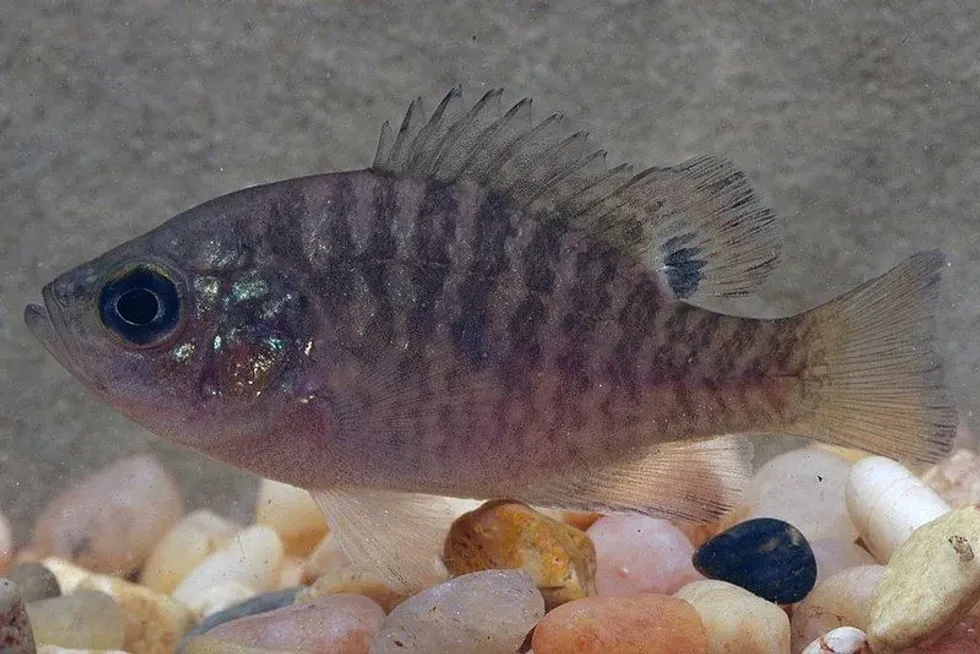The bantam sunfish (Lepomis symmetricus) is a member of the sunfish family and the Lepomis genus of fish. Bantam sunfish are bland in color and there is no way to differentiate between breeding individuals as both non-breeding males and females are identical to breeding male and females.
Bantam sunfish are the smallest of all sunfish species that can be found in North America and are historically associated with the state of Illinois as they are found in the muddy and swampy waters of the Illinois region.
However, the population of this fish in their native Illinois has been listed as endangered as they have suffered a steep decline due to human interference in the natural habitat which has led to the destruction of their ecosystem.
Bantam sunfish (L. symmetricus) are protected by the forest service association in the state of Illinois as there have been efforts to bring the population of this fish back to their old numbers and hopefully it can be done as these fish are an important part of the natural ecosystem.
If you liked these facts about bantam sunfish, then check out our articles about the neon goby and round goby fish too.
Bantam Sunfish Interesting Facts
What type of animal is a bantam sunfish?
The bantam sunfish (Lepomis symmetricus) is a small fish species that belongs to the Lepomis genus of fish under the sunfish family Centrarchidae and comes under the Perciformes order. The bantam sunfish species is one of the least studied fish of all sunfishes as not much is known about them.
Bantam sunfish are one of the most commonly occurring fishes in the southern United States region.
What class of animal does a bantam sunfish belong to?
The bantam sunfish (Lepomis symmetricus) belong to the class of Actinopterygii and they are ray-finned fishes. Actinopterygii is divided into two different classes Cladistia and Actinopteri. Actinopterygians comprise almost 30,000 species of fishes including piranhas and other species.
How many bantam sunfish are there in the world?
The current population of bantam sunfish (Lepomis symmetricus) cannot be stated as not much is known about these fishes. However, it can be said that the population of these fishes is in the stable range as they can be abundantly found in any river system in North America that is heavily vegetated.
Where does a bantam sunfish live?
The bantam sunfish (Lepomis symmetricus) species usually occurs in dense muddy waters across North America. These freshwater fishes are found in the Mississippi embayment that ranges from the southern parts of Illinois to the Gulf of Mexico.
In the eastern and western parts of their habitat, these fishes are found in the Gulf Coast, ranging from Eagle Lake (Colorado River drainage system) in the state of Texas to the River system of Biloxi in the Mississippi.
Bantam sunfish (L. symmetricus) are common in the natural history of a few states which include Louisiana, the southeastern Texas extremes, western Kentucky, southern Arkansas, and parts of western Tennessee. These fishes can also be found in Illinois, mostly in the extreme southwestern parts, Missouri's bootheel, McCurtain County in the state of Oklahoma, and drainage systems.
Bantam sunfish can be found in an isolated population in the Illinois River at Pekin, Pine Hills, and in White County in the Wabash River drainage system, also in Illinois. These fishes have a vast distribution and life history in Wolf Lake, Illinois as they have occurred naturally in this region for centuries.
As of today, there are new records of these fishes occurring in the southern parts of Illinois as they can be found in the Clear Creek drainage all the way to the Cache River drainage system.
What is a bantam sunfish's habitat?
Bantam sunfish (Lepomis symmetricus) prefer to live in areas that have dense vegetation, swamps, lakes, sloughs, and muddy waters. They live in areas that have plenty of cover to protect them from predators like large fish and birds. Bantam sunfish can be easily found at the bottom of muddy waters with decaying plants.
The scattered population of these species occurs in the south-central United States, with most of them being in Illinois as these fish have a vast distribution and life history in Wolf Lake. They can also be found in muddy rivers, lakes, and ponds in parts of southern Arkansas and across western Tennessee.
Who do bantam sunfish live with?
Due to a lack of data, it cannot be stated if bantam sunfish (Lepomis symmetricus) are solitary fish or a schooling group of fish. They can however be found in small groups during the breeding season as they come together to mate.
How long does a bantam sunfish live?
Bantam sunfish (Lepomis symmetricus) have a short lifespan and live up to a maximum of three years in the wild. Even if you get a bantam sunfish as a pet and provide it with the best care with ample food, great water, and habitat, it is tough to extend their life from their maximum of three years.
How do they reproduce?
Both male and female bantam sunfish (L. symmetricus) sexually mature when they are a year old. The breeding period of these fish is between mid-April to early June.
Bantam sunfish (Lepomis symmetricus) are nest spawners and large males nudge females with their snout and nip their caudal fin.
Males are aggressive when it comes to guarding their territory and will move back and forth in their territory until they are approached by a receptive female.
This movement includes the males swimming closely towards the female which is followed by a sharp turn back to the nest. These bantam sunfish habits are repeated until the female is responsive and if the female does not respond, the male will drive the female out of his territory.
When the courtship is a success, the female will follow the male back to the nest and they will engage in the mating procedure.
After the female has been inseminated, she will lay 219-1600 ova that will change color to orange right after spawning. In the case of captive breeding in an aquarium, it is suggested to remove the male and the female from the aquarium as they might eat the eggs.
What is their conservation status?
Currently, these freshwater fishes are listed as a species of Least Concern on the IUCN Red List due to these fishes being found abundantly in the wild.
However, as reported by the USDA Forest Service, this species is listed as Threatened due to an alarming rate of population decline in Illinois due to human interference which has resulted in environmental degradation causing drainage of wetlands.
It has been stated that efforts are in place to get these species back into Illinois, which is their historic home as they have had a wide distribution and life history in Wolf Lake.
Bantam Sunfish Fun Facts
What do bantam sunfish look like?
Bantam sunfish (Lepomis symmetricus) is a bland-looking species, maybe the blandest of all the sunfish species as besides the reddish-brown colored body, not much coloration can be found on them. A bit of bluish, greenish, and yellowish color can be found on the midline of the body.
The back of the body is dark green with spots that are dark brown. The body is compressed and deep like other sunfish species and the symmetrical shape of their body gives them the scientific name of Lepomis symmetricus.
Bantam sunfish are the only members of the sunfish family that have irregular or incomplete lateral lines on their bodies that are one to 18 in number. A black botch on the anal fin is rare but is commonly found in their relative the green sunfish.

* Please note that this is an image of a pumpkinseed sunfish, which belongs to the same genus as the bantam sunfish. If you have an image of a bantam sunfish please let us know at hello@kidadl.com.
How cute are they?
It is difficult to call these fish cute due to their rough appearance. In a community tank setup, these fish will stand out due to their appearance so they might be eye-catching but not cute.
How do they communicate?
All fish have otoliths consisting of a sensory epithelium made up of calcareous otoliths and their hair cells that they use to communicate with each other.
How big is a bantam sunfish?
The bantam sunfish (Lepomis symmetricus) is the smallest sunfish that is found in North America and grows only up to 3.5 in (8.8 cm) in length.
How fast can a bantam sunfish swim?
Due to a lack of data, the speed at which L. symmetricus fish swim is not known.
How much does a bantam sunfish weigh?
Not much is known about the weight of bantam sunfish due to a lack of data.
What are the male and female names of the species?
No specific name has been assigned to either sex of this fish species.
What would you call a baby bantam sunfish?
A baby bantam sunfish (Lepomis symmetricus), like most fish babies, is called a fry.
Juvenile bantam sunfish can be differentiated from adults due to the seven to nine vertical bars on their body along with the spot on the dorsal fin, with a reddish-orange pigment on the anal and dorsal fin. Juveniles sexually mature at one year of age due to the lifespan of the bantam sunfish being low.
What do they eat?
Bantam sunfish (Lepomis symmetricus) are carnivorous in nature so their diet mostly comprises meaty foods. When they are small, they prefer to eat small crustaceans and larvae and as they grow, they shift to larger gastropods, amphipods, and insects.
In captivity, they should be fed shrimp, shellfish, krills, and earthworms as they are not picky eaters. They can also be fed good quality pellets for small fish.
Are they poisonous?
No, these fish are harmless to humans and are usually a docile species.
Would they make a good pet?
Yes, bantam sunfish (L. symmetricus) can be a great addition to an aquarium or community tank setup as they are easy to care for and are suitable for novice aquarists. They are docile in nature and only semi-aggressive so they can get along with other fish easily.
Did you know...
Bantam sunfish are a major part of the Illinois River system as they occur there in large numbers but are now endangered.
Green sunfish are often considered an invasive species. The green sunfish is the most common type of sunfish that can be caught by anglers.
The pumpkinseed sunfish has the largest native range of all the Lepomis sunfish species.
Bantam sunfish are the smallest fish in the Lepomis species!
Unlike the bantam sunfish, the green sunfish are notorious for biting so it is recommended not to go near a green sunfish-infested area.
What are the different types of sunfish?
The sunfish family is large and there are several fishes in the family such as the green sunfish, black crappies, bluegill sunfish, bluespotted sunfish, mud sunfish, pumpkinseed sunfish, longear sunfish, dollar sunfish, redear sunfish, orange-spotted sunfish, red-spotted sunfish, and the red-breast sunfish.
The bass fish also comes under the sunfish family and includes the largemouth bass, smallmouth bass, and rock bass. Most of these sunfish are native to North America.
Can sunfish and goldfish live together?
Yes, sunfish can get along fine with goldfish, given that they are smaller than goldfish. Bantam sunfish in aquarium setups are usually docile and will not harm other fish that are bigger or similar in size to them.
Here at Kidadl, we have carefully created lots of interesting family-friendly animal facts for everyone to discover! For more relatable content, check out these Lambchop rasbora facts and pigfish facts for kids.
You can even occupy yourself at home by coloring in one of our free printable Bantam sunfish coloring pages.









